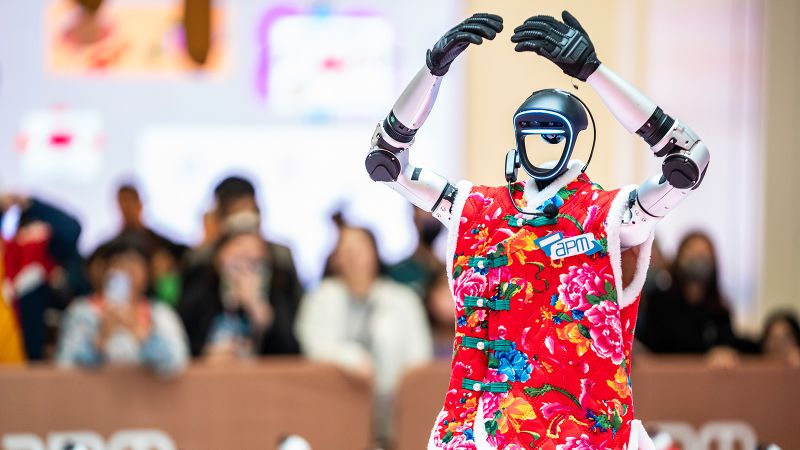The recent advancements in humanoid robotics in China have been showcased vividly during high-profile events, notably the annual Lunar New Year gala. In January, an electrifying performance featuring humanoid robots captured the attention of more than a billion viewers, underlining the significant strides made in this technological sector. These sophisticated machines not only entertained the audience by spinning bright red handkerchiefs and dancing to folk music but also demonstrated a wider narrative about the technological prowess and economic aspirations of China.
Humanoid robots are increasingly becoming a focal point for innovation and economic growth in China. Popular videos circulating online display these robots executing complex moves such as riding bicycles, performing roundhouse kicks, and side flips, which have further increased their visibility. These advances are frequently promoted by state media, emphasizing the potential of humanoid robots to spur economic opportunities. Despite the fact that very few of these robotic entities are produced on a mass scale, the competitive landscape is heating up. Notably, companies like Tesla, led by Elon Musk, are prominent players in the robotics domain. Musk’s introduction of the Optimus humanoid robot not only stirred global interest but he has also claimed that its development could unlock revenues exceeding $10 trillion.
Despite the current state where humanoid robots have not yet integrated significantly into daily life, experts hint at a future where they could become as ubiquitous as smartphones and automobiles. Xi Ning, a chair professor in robotics and automation at the University of Hong Kong, suggested that in the future, a wide array of consumers will need humanoid robots to assist in various capacities, potentially tapping into a colossal market. Projections from Goldman Sachs estimate that the global humanoid robot market could be worth around $38 billion by 2035.
China’s government is keen to replicate its successful electric vehicle (EV) market in the humanoid robotics sector. With a focus on securing its position as a global technology leader, ongoing advancements in artificial intelligence and robotics are being propelled by substantial government support and funding. The Chinese government has pledged funding to numerous ventures aimed at innovating in robotics, particularly in humanoids, further demonstrating the sector’s strategic importance.
However, even amidst rapid development, it is noted that Chinese firms entered the humanoid robotics race later than their American counterparts, such as Boston Dynamics and Figure AI. Yet, they are closing the technological gap with their ability to optimize supply chains and reduce costs markedly. The International Federation of Robotics reports that since 2021, China has been deploying more industrial robots than all other nations combined, marking its dominance in various robotic technologies.
Though considered simpler than humanoids, industrial robots remain critical, performing essential tasks in manufacturing and logistics. In comparison, the more advanced humanoid robots command significant attention with their potential for diverse applications. In alignment with this, the Chinese government has outlined its ambitions to become a world leader in humanoid robotics in policy documents, setting forth aggressive timelines for mass production and securing supply chains for essential components by 2025.
Nonetheless, experts caution that while China holds the lion’s share of the supply chain—covering about 56% of humanoid robot supply companies—breakthroughs in core technologies like advanced sensor systems, operating systems, and high-performance chips are crucial. Many of today’s humanoid robotics depend on sophisticated AI systems, with leading companies like Nvidia shaping the foundational technology.
Moreover, international trade restrictions from Western nations concerning advanced electronics have prompted China to enhance its domestic chip manufacturing efforts, with attempts to reduce reliance on foreign technology. The competitive dynamics of particularly high-precision components, sensor, and motor technology suggest that while Chinese manufacturers are leveraging lower costs, they still face challenges in technological parity.
In this evolving landscape, companies like Tesla are pivotal as they refine their supply chains through cooperation with Chinese manufacturers. This continuous cycle of collaboration and improvement is likely to stimulate advancements across the domestic humanoid robotics sector, consolidating China’s position as a crucial player in the marketplace.
At the same time, significant investments have been poured into the humanoid sector by various established electric vehicle manufacturers, indicating the increasing blend of the EV and robotics industries. The fact that advanced manufacturing processes for humanoid robots share similarities with those in electric vehicles positions companies like BYD and XPeng as formidable entrants in the field.
Lastly, as China’s demographic challenges intensify, particularly with a declining labor force, humanoid robots are viewed not just as technological gadgets but as essential components in strategizing economic resilience. The leadership’s investment in this innovation reflects the urgent need for solutions that could bridge labor shortages and enhance productivity during these transformative economic times.



